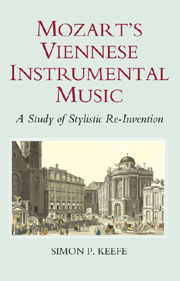Book contents
- Frontmatter
- Contents
- List of Musical Examples
- List of Figures
- For Celia, Abraham and Madeleine
- Acknowledgements
- Introduction: Mozart and Stylistic Re-Invention
- I PIANO CONCERTOS
- II STRING QUARTETS
- III SYMPHONIES
- 6 The ‘Jupiter’ Symphony in C, K. 551: The Dramatic Finale and its Stylistic Significance in Mozart's Orchestral Oeuvre
- IV CONCLUSIONS
- Bibliography
- Index of Mozart's Works by Köchel Number
- Index of Mozart's Works by Genre
- General Index
6 - The ‘Jupiter’ Symphony in C, K. 551: The Dramatic Finale and its Stylistic Significance in Mozart's Orchestral Oeuvre
from III - SYMPHONIES
Published online by Cambridge University Press: 05 September 2013
- Frontmatter
- Contents
- List of Musical Examples
- List of Figures
- For Celia, Abraham and Madeleine
- Acknowledgements
- Introduction: Mozart and Stylistic Re-Invention
- I PIANO CONCERTOS
- II STRING QUARTETS
- III SYMPHONIES
- 6 The ‘Jupiter’ Symphony in C, K. 551: The Dramatic Finale and its Stylistic Significance in Mozart's Orchestral Oeuvre
- IV CONCLUSIONS
- Bibliography
- Index of Mozart's Works by Köchel Number
- Index of Mozart's Works by Genre
- General Index
Summary
DISCUSSION of stylistic re-invention in Mozart's Viennese symphonies is rinherently more problematic than corresponding discussion of his concertos and quartets: after all, he wrote only six symphonies in Vienna as opposed to 17 piano concertos and 10 string quartets. In contrast to his pre-1781 orchestral output (numerous serenades, cassations and divertimenti and at least 34 symphonies) the Viennese symphonies occupy only a small place in his compositional output as a whole, a discrepancy in numbers of pre- and post-1781 works that is either not evident, or not as pronounced, in his concerto and quartet repertories. What is more (and even by his own remarkable standards), Mozart apparently composed all of his Viennese symphonies, with the possible exception of the ‘Prague’, K. 504 (1786), in real haste, a state of affairs perhaps not conducive at first glance to the reflection and re-appraisal that comprise stylistic re-invention.
It is difficult to argue, however, that a stylistic study of the relationship between Mozart's Viennese symphonies set in historical and aesthetic contexts is not a worthwhile topic for scholarly investigation. Collectively these works are contenders for Mozartian highpoints in a number of stylistic domains, including topical and gestural heterogeneity and complexity (K. 504), conspicuous harmonic audacity (K. 550, see Chapter 3) and contrapuntal intricacy and sophistication (K. 551/iv). It is hard too to counter the oft-voiced opinion that the Viennese symphonies represent Mozart's greatest achievement in orchestral genres (setting aside the concerto), especially for stylistic issues such as instrumental interaction, orchestral effects and obligato wind writing, even accepting that earlier benchmark works exist, including the G-minor Symphony, K. 183 (1773), the ‘Paris’ Symphony, K. 297 (1778) and the ‘Posthorn’ Serenade, K. 320 (1779).
- Type
- Chapter
- Information
- Mozart's Viennese Instrumental MusicA Study of Stylistic Re-Invention, pp. 137 - 164Publisher: Boydell & BrewerPrint publication year: 2007



